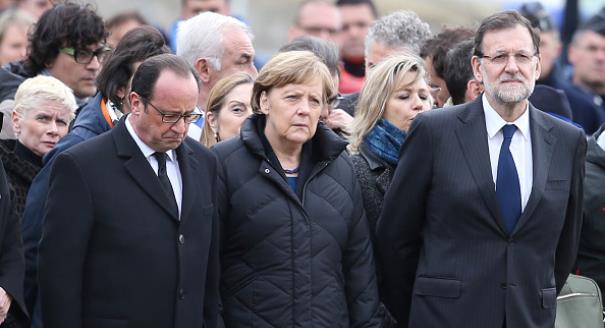Europe and the world are in great shock after the Germanwings tragedy of March 24, when Flight 9525 from Barcelona to Düsseldorf was deliberately crashed in the French Alps, killing all 150 on board.
Beyond the horror and the profound emotions, beyond the tsunami of reports and opinions in the media, there may be room for a more political view of this catastrophe.
When the gathering is over, the leaders swiftly go back to their capitals, while the overwhelming majority of European citizens don’t have a clue about what was discussed or whether it will improve their daily lot.
This time, a pan-European tragedy triggered a collective European reaction. French President François Hollande, German Chancellor Angela Merkel, and Spanish Prime Minister Mariano Rajoy gathered instantly near the site of the crash, clad in their parkas, standing in the grass and the mud. They talked not with their peers and political advisers, but to real people—the local mayors, villagers, fire and rescue officers, gendarmerie, and forensic pathologists.
From the three countries concerned, all relevant administrations worked closely together. Red Cross teams traveled from Germany and Spain, and there was a great outpouring of solidarity in Seyne-les-Alpes, near the crash site, as well as in Barcelona and Düsseldorf. In the French Alps, when the local population heard that victims’ families would come to visit, citizens offered rooms to host them. German- and Spanish-language teachers from colleges in the region came to translate, and people hugged even though they didn’t speak each other’s languages.
While the airplane crash became more and more surreal as its horrific details were made public, another piece of news emerged: Europe was perhaps not the dehumanized, artificial construction that is often derided in the media. Spontaneously, Europeans saw a “one nation” reaction, as if the only way to cope with the incomprehensible nature of the tragedy was through European solidarity among states, administrations, and citizens alike.
#Europe may not be the dehumanized, artificial construction often derided in the media.Tweet This
In another European dimension to the disaster, leaders and travelers realized that there was a wide discrepancy between the procedures used by different European airlines when recruiting pilots and checking their medical conditions. The chief executive of Lufthansa, who had at first issued a confident narrative based on his airline’s strong reputation, soon declared himself “speechless.” After having initially put his full confidence in his company’s procedures, he rapidly had them changed.
The airline industry in Europe and beyond, fearing a collapse of passenger confidence, quickly adopted new measures on pilot presence in the cockpit, after it emerged that the first officer of the Germanwings plane had locked the captain out of the flight deck. Similarly, the industry is now rushing to review its staff recruitment and management procedures. Faced with an unprecedented commercial, financial, and psychological challenge, the European airline industry now has to react fast and big.
European citizens, mesmerized by the gaps in safety procedures, will not easily accept piecemeal, differentiated reactions between one country and another, between one airline and another. There is a clear need for an EU-wide reaction. For once, the European Commission could usefully take a rapid initiative to reassure citizens and propose common rules and procedures in a field that is understandable by all.
If there were a time when the EU could prove the usefulness of its institutions and the meaning of the much-touted single market, it is now, in the wake of the Germanwings tragedy. This is not a case of Germany against other member states, it is not one airline group against its competitors. This is about the need for a common surge toward a safer European airline industry and a higher level of security for travelers.
#EU leaders should show the meaning of the European ideal.Tweet This
Finally, this tragedy provides room for a lasting symbol of European solidarity. The valley and ridge near Seyne-les-Alpes will remain the site of one of worst European air disasters—in terms not only of sheer numbers but also of the symbolic value of one human being taking 149 others in his final voyage. The crash location will continue to be a place where families and friends of the victims will want to come and pay their respects. The few square miles where the catastrophe happened should be made a European memorial park dedicated to all those who perished there.
Beyond the incomprehensible act of a young pilot, European leaders and institutions should seize the moment to show their people the humane meaning of the European ideal. In today’s brutal world, that would represent no small achievement.








